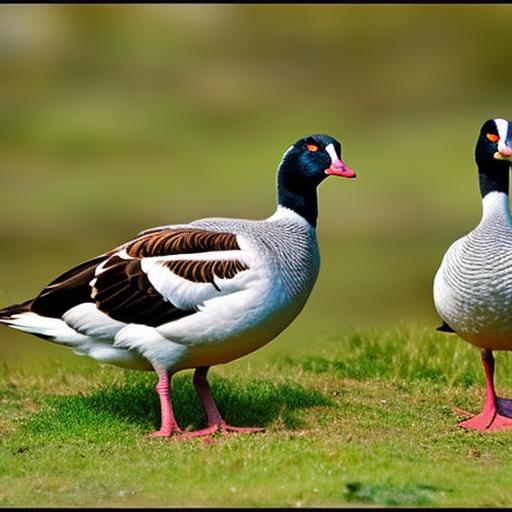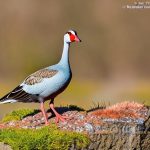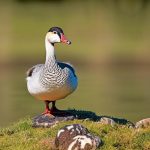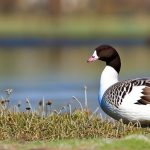Domestic geese have been a part of human civilization for thousands of years. They were first domesticated in ancient Egypt and have since spread to various parts of the world. These birds are known for their large size, distinctive honking sound, and their ability to adapt to different environments.
Domestic geese come in a variety of breeds, each with its own unique characteristics. Some breeds are known for their size and meat production, while others are prized for their egg-laying abilities or ornamental features. Regardless of the breed, domestic geese are generally social animals that form strong bonds with their owners.
Key Takeaways
- Domestic geese breeds have been around for centuries and have been bred for various purposes such as meat, eggs, and feathers.
- Some popular domestic geese breeds include Toulouse, Embden, African, Chinese, Pilgrim, Sebastopol, and American Buff.
- Toulouse geese are the largest domestic goose breed and are known for their calm and docile nature.
- Embden geese are a beautiful white breed that are often used for ornamental purposes.
- African geese are the noisiest and most aggressive breed, while Chinese geese are known for their elegance and grace.
Popular Domestic Geese Breeds: An Overview
There are several popular domestic geese breeds that are commonly raised for meat, eggs, or as pets. These breeds include Toulouse geese, Embden geese, African geese, Chinese geese, Pilgrim geese, Sebastopol geese, and American Buff geese.
Toulouse geese are the largest domestic goose breed and are known for their size and meat production. They have a calm and friendly temperament, making them suitable for both commercial farming and backyard rearing.
Embden geese are known for their pure white feathers and elegant appearance. They are also a large breed and are often raised for meat production. However, they can also be kept as pets due to their docile nature.
African geese are known for being noisy and aggressive. They have a distinctive knob on their forehead and are often used as guard animals due to their loud honking and territorial behavior.
Chinese geese are known for their graceful appearance and slender necks. They are primarily raised for meat production but can also be kept as ornamental birds due to their elegant features.
Pilgrim geese are a unique breed that is known for its sex-linked feather coloration. Males and females have different feather colors, making it easy to determine their gender at a young age. They are friendly and docile birds, making them suitable for both meat production and as pets.
Sebastopol geese are known for their curly feathers, which give them a unique and ornamental appearance. They are primarily kept as pets or for exhibition purposes due to their distinctive feathers.
American Buff geese are a heritage breed that is known for its rich flavor and high-quality meat. They are also good egg layers and have a calm and friendly temperament.
Toulouse Geese: The Largest Domestic Goose Breed
Toulouse geese are the largest domestic goose breed, with males weighing up to 30 pounds and females weighing up to 20 pounds. They have a calm and friendly temperament, making them easy to handle and suitable for both commercial farming and backyard rearing.
Toulouse geese have a distinctive appearance, with a grayish-brown plumage and a knob on their forehead. They are primarily raised for meat production due to their large size and high meat yield. However, they can also be kept as pets or for exhibition purposes due to their unique features.
The history of Toulouse geese can be traced back to the region of Toulouse in France, where they were first bred for their meat. They were later imported to England and the United States, where they gained popularity as a commercial meat breed.
Fun facts about Toulouse geese include their ability to live in various climates, their strong maternal instincts, and their loud honking sound. They are also known for their intelligence and can be trained to perform simple tasks.
Embden Geese: The White Beauty of Domestic Geese
Embden geese are known for their pure white feathers and elegant appearance. They are a large breed, with males weighing up to 30 pounds and females weighing up to 20 pounds. They are primarily raised for meat production but can also be kept as pets due to their docile nature.
Embden geese have a calm and friendly temperament, making them easy to handle and suitable for both commercial farming and backyard rearing. They are also good egg layers, with females laying up to 40 eggs per year.
The history of Embden geese can be traced back to the town of Embden in Germany, where they were first bred for their meat and feathers. They were later imported to England and the United States, where they gained popularity as a commercial meat breed.
Fun facts about Embden geese include their ability to adapt to different environments, their strong bond with their owners, and their ability to live for up to 20 years. They are also known for their loud honking sound, which they use to communicate with each other.
African Geese: The Noisiest and Most Aggressive Breed
African geese are known for being noisy and aggressive. They have a distinctive knob on their forehead and are often used as guard animals due to their loud honking and territorial behavior.
African geese are a large breed, with males weighing up to 25 pounds and females weighing up to 20 pounds. They have a grayish-brown plumage with white markings on their chest and belly.
The history of African geese can be traced back to the region of Africa, where they were first bred for their meat and feathers. They were later imported to Europe and the United States, where they gained popularity as a commercial meat breed.
Fun facts about African geese include their ability to live in various climates, their aggressive nature towards other animals, and their loud honking sound. They are also known for their strong bond with their owners and their ability to recognize familiar faces.
Chinese Geese: The Elegant and Graceful Breed
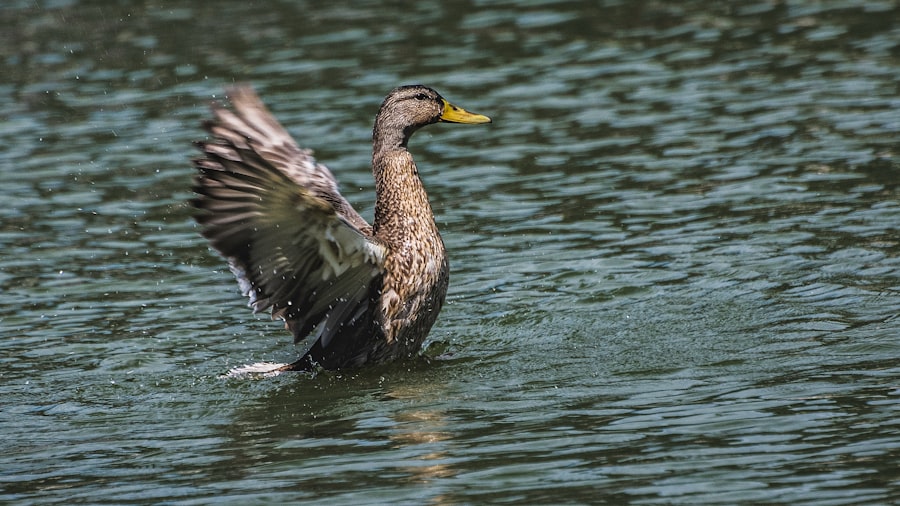
Chinese geese are known for their graceful appearance and slender necks. They are a medium-sized breed, with males weighing up to 12 pounds and females weighing up to 10 pounds. They are primarily raised for meat production but can also be kept as ornamental birds due to their elegant features.
Chinese geese have a calm and friendly temperament, making them easy to handle and suitable for both commercial farming and backyard rearing. They are also good egg layers, with females laying up to 50 eggs per year.
The history of Chinese geese can be traced back to China, where they were first bred for their meat and feathers. They were later imported to Europe and the United States, where they gained popularity as a commercial meat breed.
Fun facts about Chinese geese include their ability to fly long distances, their strong bond with their owners, and their ability to live for up to 15 years. They are also known for their distinctive hissing sound, which they use to communicate with each other.
Pilgrim Geese: The Friendly and Docile Breed
Pilgrim geese are a unique breed that is known for its sex-linked feather coloration. Males have a grayish-brown plumage, while females have a white plumage. This makes it easy to determine their gender at a young age.
Pilgrim geese have a calm and friendly temperament, making them easy to handle and suitable for both meat production and as pets. They are a medium-sized breed, with males weighing up to 18 pounds and females weighing up to 16 pounds.
The history of Pilgrim geese can be traced back to the United States, where they were first bred by a man named Dave Holderread in the 1980s. They were named after the Pilgrims who settled in America, as they were believed to have been brought over by them.
Fun facts about Pilgrim geese include their ability to adapt to different environments, their strong maternal instincts, and their ability to live for up to 15 years. They are also known for their calm and friendly nature, making them suitable for both commercial farming and backyard rearing.
Sebastopol Geese: The Curly Feathered Breed
Sebastopol geese are known for their curly feathers, which give them a unique and ornamental appearance. They are a medium-sized breed, with males weighing up to 14 pounds and females weighing up to 12 pounds.
Sebastopol geese have a calm and friendly temperament, making them easy to handle and suitable for both meat production and as pets. They are primarily kept as pets or for exhibition purposes due to their distinctive feathers.
The history of Sebastopol geese can be traced back to the region of Sebastopol in Russia, where they were first bred for their ornamental feathers. They were later imported to Europe and the United States, where they gained popularity as an exhibition breed.
Fun facts about Sebastopol geese include their ability to fly long distances, their strong bond with their owners, and their ability to live for up to 15 years. They are also known for their unique feather patterns, which can vary from bird to bird.
American Buff Geese: The Heritage Breed of Domestic Geese
American Buff geese are a heritage breed that is known for its rich flavor and high-quality meat. They are a medium-sized breed, with males weighing up to 18 pounds and females weighing up to 16 pounds.
American Buff geese have a calm and friendly temperament, making them easy to handle and suitable for both meat production and as pets. They are also good egg layers, with females laying up to 40 eggs per year.
The history of American Buff geese can be traced back to the United States, where they were first bred in the early 20th century. They were named after their buff-colored feathers, which range from a light cream to a deep golden color.
Fun facts about American Buff geese include their ability to adapt to different environments, their strong maternal instincts, and their ability to live for up to 20 years. They are also known for their calm and friendly nature, making them suitable for both commercial farming and backyard rearing.
Domestic Geese Breeding: Tips and Techniques for Successful Rearing
Breeding domestic geese can be a rewarding experience, but it requires careful planning and preparation. Here are some tips and techniques for successful domestic geese breeding:
1. Choose the right breed: Before starting a breeding program, it’s important to choose the right breed of domestic geese. Consider your goals and preferences, whether it’s meat production, egg-laying abilities, or ornamental features.
2. Provide proper housing: Domestic geese require a secure and spacious housing area. Provide them with a shelter that protects them from the elements and predators. Make sure there is enough space for them to move around and access to fresh water.
3. Feed a balanced diet: Domestic geese require a balanced diet that includes grains, greens, and protein sources. Provide them with a commercial feed that is specifically formulated for geese or create your own feed mix.
4. Monitor health and hygiene: Regularly monitor the health of your geese and provide them with proper veterinary care when needed. Keep their housing area clean and provide them with fresh water and bedding.
5. Manage breeding season: Geese have a natural breeding season that typically occurs in the spring. Provide them with nesting boxes or areas where they can lay their eggs. Allow them to incubate their eggs or use an incubator if you want to hatch the eggs yourself.
6. Socialize the goslings: Once the goslings hatch, it’s important to socialize them with humans and other geese. Handle them gently and provide them with plenty of interaction to ensure they grow up to be friendly and well-adjusted birds.
Common mistakes to avoid when breeding domestic geese include overcrowding, improper nutrition, and neglecting their health and hygiene needs. It’s important to provide them with a suitable environment and proper care to ensure their well-being and successful breeding.
In conclusion, domestic geese breeds are fascinating creatures with unique characteristics and histories. Whether you’re interested in raising them for meat, eggs, or simply as pets, there’s a breed out there for everyone. With the right knowledge and techniques, successful domestic geese breeding is within reach.
If you’re interested in learning more about geese breeds and how to domesticate them, you might also find this article on poultrywizard.com helpful. It provides valuable insights into the different types of geese breeds that are suitable for domestication and offers tips on how to care for them. Check it out here: https://poultrywizard.com/keeping-chickens/chicken-coop-grand-island-ne/.
FAQs
What are domestic geese breeds?
Domestic geese breeds are those that have been selectively bred by humans for their meat, eggs, feathers, or ornamental purposes. They are different from wild geese, which are not domesticated.
What are some common domestic geese breeds?
Some common domestic geese breeds include Toulouse, Embden, African, Chinese, and Sebastopol. Each breed has its own unique characteristics in terms of size, color, and temperament.
What is the size of domestic geese?
Domestic geese can vary in size depending on the breed. Some breeds, such as the Toulouse, can weigh up to 30 pounds, while others, such as the Chinese, are smaller and weigh around 8-10 pounds.
What is the lifespan of domestic geese?
Domestic geese can live up to 20 years or more, depending on their breed and living conditions. However, most domestic geese are raised for meat or egg production and are typically slaughtered before they reach their full lifespan.
What are domestic geese used for?
Domestic geese are used for a variety of purposes, including meat production, egg production, feather production, and as ornamental birds. They are also used for weed control and as pets.
What is the temperament of domestic geese?
The temperament of domestic geese can vary depending on the breed and their upbringing. Some breeds, such as the African and Chinese, are known for being more docile and friendly, while others, such as the Embden, can be more aggressive.
What is the diet of domestic geese?
Domestic geese are omnivores and eat a variety of foods, including grass, grains, insects, and small animals. They also require access to clean water for drinking and bathing.
Meet Walter, the feathered-friend fanatic of Florida! Nestled in the sunshine state, Walter struts through life with his feathered companions, clucking his way to happiness. With a coop that’s fancier than a five-star hotel, he’s the Don Juan of the chicken world. When he’s not teaching his hens to do the cha-cha, you’ll find him in a heated debate with his prized rooster, Sir Clucks-a-Lot. Walter’s poultry passion is no yolk; he’s the sunny-side-up guy you never knew you needed in your flock of friends!

